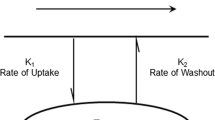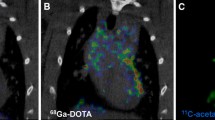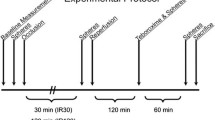Abstract
Background. Technetium 99m-N-MPO ([Tc-99m-N(mpo)(PNP5)]+) is a cationic Tc-99m nitrido complex. The objective of this study is to evaluate its potential as a new radiotracer for myocardial perfusion imaging.
Methods and Results. Biodistribution studies were performed in Sprague-Dawley rats and guinea pigs to compare the myocardial uptake and excretion kinetics of Tc-99m-N-MPO from noncardiac organs, such as the liver and lungs, with those of the known cationic Tc-99m radiotracers: Tc-99m-N-DBODC5 and Tc-99m-sestamibi. Planar imaging was performed in Sprague-Dawley rats to evaluate the utility of Tc-99m-N-MPO as a myocardial perfusion imaging agent. Metabolism studies were carried out by use of both Sprague-Dawley rats and guinea pigs. In general, the heart uptake of Tc-99m-N-MPO was between that of Tc-99msestamibi and Tc-99m-N-DBODC5 over the 2-hour study period. However, the heart-liver ratio of Tc-99m-N-MPO (12.75±3.34) at 30 minutes after injection was more than twice that of Tc-99m-N-DBODC5 (6.01±1.45) and approximately 4 times higher than that of Tc-99msestamibi (2.90±0.22). The heart uptake and heart-liver ratio of Tc-99m-N-MPO and Tc-99m-sestamibi in guinea pigs were significantly lower than those obtained in Sprague-Dawley rats. The metabolism studies demonstrated no detectable Tc-99m-N-MPO metabolites in the urine and feces samples of the Sprague-Dawley rats at 120 minutes after injection. In guinea pigs no Tc-99m-N-MPO metabolites were detected in the urine at 120 minutes, but only approximately 60% of Tc-99m-N-MPO remained intact in the feces samples. In contrast, there was no intact Tc-99m-sestamibi detected in urine samples, and less than 15% of Tc-99m-sestamibi remained intact in the feces samples. Planar imaging studies indicated that clinically useful images of the heart may be obtained as early as 15 minutes after injection of Tc-99m-N-MPO.
Conclusion. The combination of favorable organ biodistribution and myocardial uptake with rapid liver clearance makes Tc-99m-N-MPO a very promising myocardial perfusion radiotracer worthy of further evaluation in various preclinical animal models.
Similar content being viewed by others
References
Nunn AD. Radiopharmaceuticals for imaging myocardial perfusion. Semin Nucl Med 1990;20:111–8.
Saha GB, Go RT, Macintyre WJ. Radiopharmaceuticals for cardiovascular imaging. Nucl Med Biol 1992;19:1–20.
Opie LH, Hesse B. Radionuclide tracers in the evaluation of resting myocardial ischaemia and viability. Eur J Nucl Med 1997;24:1183–93.
Berman DS, Germano G, Shaw LJ. The role of nuclear cardiology in clinical decision making. Semin Nucl Med 1999;29:280–97.
Jain D. Technetium-99m labeled myocardial perfusion imaging agents. Semin Nucl Med 1999;29:221–36.
Acampa W, Di Benedetto C, Cuocolo A. An overview of radiotracers in nuclear cardiology. J Nucl Cardiol 2000;7:701–7.
Dilsizian V. The role of myocardial perfusion imaging in vascular endothelial dysfunction. J Nucl Cardiol 2000;7:180–4.
Beller GA, Zaret BL. Contributions of nuclear cardiology to diagnosis and prognosis of patients with coronary artery disease. Circulation 2000;101:1465–78.
Banerjee S, Pillai MRA, Ramamoorthy N. Evolution of Tc-99m in diagnostic radiopharmaceuticals. Semin Nucl Med 2001;31:260–77.
Parker JA. Cardiac nuclear medicine in monitoring patients with coronary heart disease. Semin Nucl Med 2001;31:223–37.
Kapur A, Latus KA, Davies G, Dhawan RT, Eastick S, Jarritt PH, et al. A comparison of three radionuclide myocardial perfusion tracers in clinical practice: The ROBUST study. Eur J Nucl Med 2002;29:1608–16.
Kailasnath P, Sinusas AJ. Comparison of Tl-201 with Tc-99mlabeled myocardial perfusion agents: Technical, physiological, and clinic issues. J Nucl Cardiol 2001;8:482–98.
Llaurado JG. The quest for the perfect myocardial perfusion indicator. . . still a long way to go. J Nucl Med 2001;42:282–4.
Jones AG, Abrams MJ, Davison A, Brodack JW, Toothaker AK, Adelstein SJ, et al. Biological studies of a new class of technetium complexes: The hexakis(alkylisonitrile)technetium(I) cations. Int J Nucl Biol 1984;11:225–34.
Wackers FJT, Berman DS, Maddahi J, Watson DD, Beller GA, Strauss HW, et al. Technetium-99m hexakis 2-methoxyisobutyl isonitrile: Human biodistribution, dosimetry, safety, and preliminary comparison to Tl-201 for myocardial perfusion imaging. J Nucl Med 1989;30:301–11.
Iskandrian AS, Heo JY, Kong B, Lyons E, Marsch S. Use of technitium-99m isonitrile (RP-30A) in assessing left ventricular perfusion and function at rest and during exercise in coronary artery disease and comparison with coronary arteriography and exercise thallium-201 SPECT imaging. Am J Cardiol 1989;64:270–5.
Marmion ME, Woulfe SR, Neumann WL, Nosco DL, Deutsch E. Preparation and characterization of technetium complexes with Schiff-base and phosphine coordination. 1. Complexes of technetium- 99g and -99m with substituted acac2en and trialkyl phosphines (where acac2en=N,N′-ethylenebis[acetylacetone iminato]). Nucl Med Biol 1999;26:755–70.
Lisic EC, Heeg MJ, Deutsch E. 99mTc(L-L)3 + complexes containing ether analogs of DMPE. Nucl Med Biol 1999;26:563–71.
Tisato F, Maina T, Shao LR, Heeg MJ, Deutsch E. Cationic [99mTcIII(DIARS)2(SR)2]+ complexes as potential myocardial perfusion imaging agents (DIARS=o-phenylenebis(dimethylarsine); SR−=thiolate). J Med Chem 1996;39:1253–61.
Boschi A, Bolzati C, Uccelli L, Duatti A, Benini E, Refosco F, et al. A class of asymmetrical nitrido 99mTc heterocomplexes as heart imaging agents with improved biological properties. Nucl Med Commun 2002;23:689–93.
Boschi A, Uccelli L, Bolzati C, Duatti A, Sabba N, Moretti E, et al. Synthesis and biologic evaluation of monocationic asymmetrical 99mTc-nitride heterocomplexes showing high heart uptake and improved imaging properties. J Nucl Med 2003;44:806–14.
Hatada K, Riou LM, Ruiz M, Yamamichi Y, Duatti A, Lima RL, et al. 99mTc-N-DBODC5, a new myocardial perfusion imaging agent with rapid liver clearance: Comparison with 99mTc-sestamibi and 99mTc-tetrofosmin in rats. J Nucl Med 2004;45:2095–101.
Hatada K, Ruiz M, Riou LM, Lima RL, Goode AR, Watson DD, et al. Organ distribution and myocardial uptake, washout, and redistribution kinetics of Tc-99m N-DBODC5 when injected during vasodilator stress in canine models of coronary stenoses. J Nucl Cardiol 2006;13:779–90.
Liu S. Ether and crown ether-containing cationic 99mTc complexes useful as radiopharmaceuticals for heart imaging. Dalton Trans 2007:1183–93.
Liu S, He ZJ, Hsieh WY, Kim YS. Evaluation of novel cationic 99mTc-nitrido complexes radiopharmaceuticals for heart imaging: Improving liver clearance with crown ether groups. Nucl Med Biol 2006;33:419–32.
Kim YS, He ZJ, Hsieh WY, Liu S. Synthesis, characterization and X-ray crystal structure of [Re(PNP)(CO)3]Br·2CH3OH: Model compound for a new class of cationic 99mTc radiotracers. Inorg Chim Acta 2 2006;359:2479–88.
He ZJ, Hsieh WY, Kim YS, Liu S. Evaluation of novel cationic 99mTc(I)-tricarbonyl complexes as potential radiotracers for myocardial perfusion imaging. Nucl Med Biol 2006;33:1045–53.
Liu S, He ZJ, Hsieh WY, Kim YS. Impact of bidentate chelators on lipophilicity, stability and biodistribution characteristics of cationic 99mTc-nitrido complexes. Bioconjug Chem 2007;18:929–36.
Kim YS, He ZJ, Hsieh WY, Liu S. A novel ternary ligand system useful for preparation of cationic 99mTc-diazenido complexes and 99mTc-labeling of small biomolecules. Bioconjug Chem 2006;17:473–84.
Piwnica-Worms D, Kronauge JF, Chiu ML. Uptake and retention of hexakis(2-methoxyisobutylisonitrile) technetium(I) in cultured chick myocardial cells: Mitochondrial and plasma membrane potential dependence. Circulation 1990;82:1826–38.
Carvalho PA, Chiu ML, Kronauge JF, Kawamura M, Jones AG, Holman BL, et al. Subcellular distribution and analysis of technetium-99m-MIBI in isolated perfused rat hearts. J Nucl Med 1992;33:1516–21.
Crane P, Laliberte R, Heminway S, Thoolen M, Orlandi C. Effect of mitochondrial viability and metabolism on technetium-99msestamibi myocardial retention. Eur J Nucl Med 1993;20:20–5.
Duchen MR. Mitochondria in health and disease: Perspectives on a new mitochondrial biology. Mol Aspects Med 2004;25:365–451.
Deutsch E, Ketring AR, Libson K, Vanderheyden J, Hirth WW. The Noah’s ark experiment: Species dependent biodistributions of cationic 99mTc complexes. Nucl Med Biol 1989;16:191–232.
Gatmaitan ZC, Arias IM. Structure and function of P-glycoprotein in normal liver and small intestine. Adv Pharmacol 1993;24:77–97.
Lee CH, Bradley G, Zhang JT, Ling V. Differential expression of P-glycoprotein genes in primary rat hepatocytes culture. J Cell Physiol 1993;157:392–402.
Mayer R, Kartenbeck J, Buchler M, Jedlitschky G, Leier I, Keppler D. Expression of the MRP gene-encoded conjugate export pump in liver and its selective absence from the canalicular membrane in transport deficient mutant hepatocytes. J Cell Biol 1995;131:137–50.
Dyszlewski M, Blake HM, Dahlheimer JL, Pica CM, Piwnica-Worms D. Characterization of a novel 99mTc-carbonyl complex as a functional probe of MDR1 P-glycoprotein transport activity. Mol Imaging 2002;1:24–35.
Muzzammil T, Ballinger JR, Moore MJ. 99mTc-sestamibi imaging of inhibition of the multidrug resistance transporter in a mouse xenograft model of human breast cancer. Nucl Med Commun 1999;20:115–22.
Del Vecchio S, Salvatore MR. 99mTc-MIBI in the evaluation of breast cancer biology. Eur J Nucl Med Mol Imaging 2004;31:S88–96.
Sharma V, Piwnica-Worms D. Metal complexes for therapy and diagnosis of drug resistance. Chem Rev 1999;99:2545–60.
Sharma V. Radiopharmaceuticals for assessment of multidrug resistance P-glycoprotein-mediated drug transport activity. Bioconjug Chem 2004;15:1464–74.
Vaidyanathan G, Zalutsky MR. Imaging drug resistance with radiolabeled molecules. Curr Pharm Des 2004;10:2965–79.
Luker GD, Francasso PM, Dobkin J, Piwbica-Worms D. Modulation of the multidrug resistance P-glycoprotein: Detection with technetium-99m sestamibi in vivo. J Nucl Med 1997;38:369–72.
Agrawal M, Abraham J, Balis FM, Edgerly M, Stein WD, Bates S, et al. Increased 99mTc-Sestamibi accumulation in normal liver and drug resistant-tumors after administration of the glycoprotein inhibitor, XR9576. Clin Cancer Res 2003;9:650–6.
Author information
Authors and Affiliations
Additional information
This work was supported, in part, by Purdue University and the following research grants: R01 CA115883 A2 (S.L.) from the National Cancer Institute, BCTR0503947 (S.L.) from the Susan G. Komen Breast Cancer Foundation, AHA0555659Z (S.L.) from the Greater Midwest Affiliate of the American Heart Association, R21 EB003419-02 (S.L.) from the National Institute of Biomedical Imaging and Bioengineering, and R21 HL083961-01 from the National Heart, Lung, and Blood Institute.
Rights and permissions
About this article
Cite this article
Kim, YS., Wang, J., Broisat, A. et al. Tc-99m-N-MPO: Novel cationic Tc-99m radiotracer for myocardial perfusion imaging. J Nucl Cardiol 15, 535–546 (2008). https://doi.org/10.1016/j.nuclcard.2008.02.022
Received:
Accepted:
Issue Date:
DOI: https://doi.org/10.1016/j.nuclcard.2008.02.022




